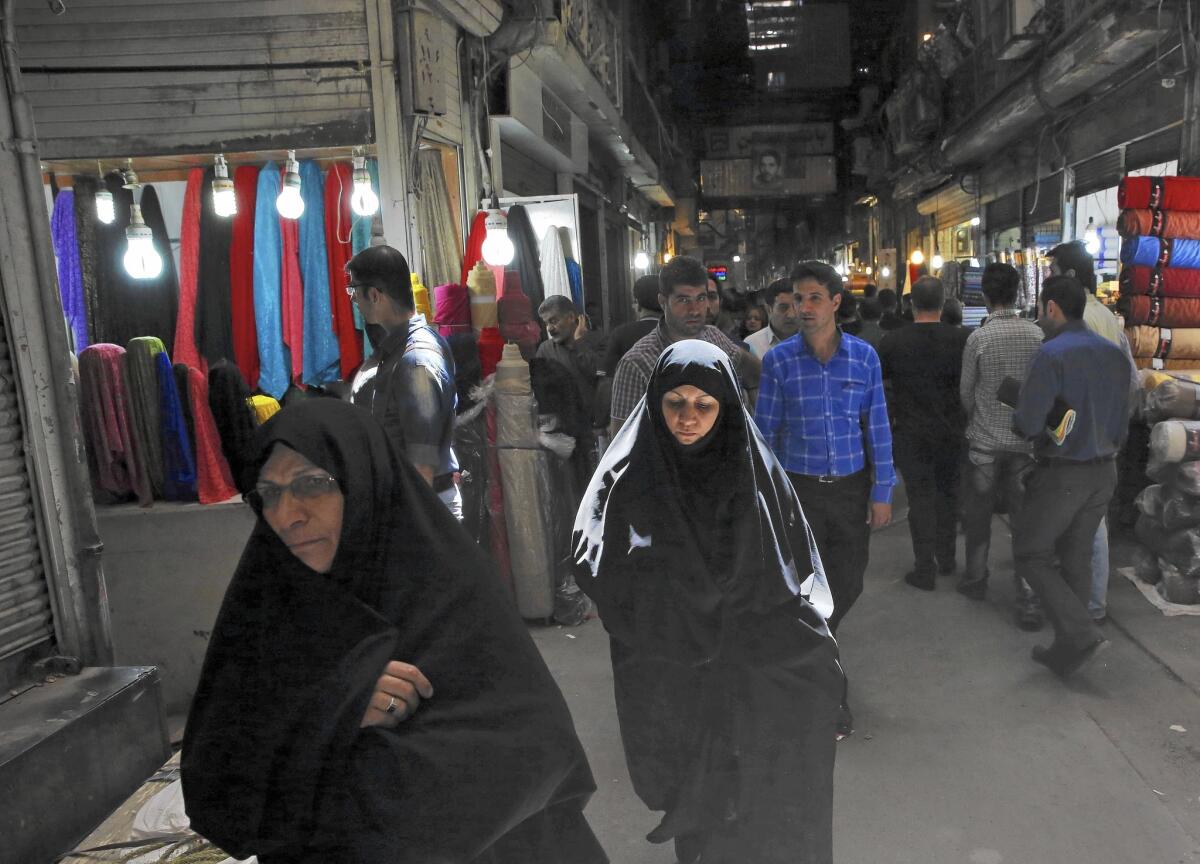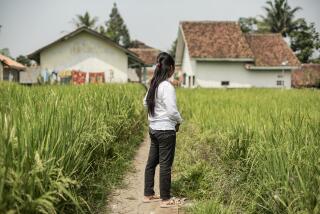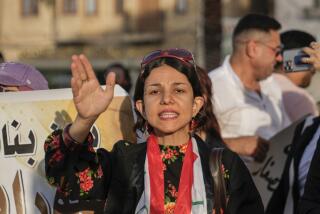‘White marriage’ a growing trend for young couples in Iran

Iran has a dress code for women, and rules about conduct in public are strict. Unmarried couples who date or engage in hand-holding can find themselves on the wrong side of the law.
Reporting from Tehran — Nina and Ahmad have lived happily together in their small one-bedroom apartment for years. They share the cost of groceries; they split the rent.
But in Iran, where Islamic teachings are woven into all aspects of life, theirs is a delicate — and illegal — arrangement: They are not married.
The pair is among a growing number of young couples in Iran who are living together without exchanging vows, a trend that the government says undermines the country’s religious values.
Last year, the chief of staff to the supreme leader, Ayatollah Ali Khamenei, called cohabitation “shameful.”
“The Islamic ruler should strongly fight this kind of life,” said Mohammad Mohammadi Golpayegani, and officials should “show no mercy” in cracking down on the practice.
In April, the government shut down a women’s magazine for dedicating a special report to cohabitation, a practice commonly referred to as “white marriage.”
There are no official estimates on the number of unmarried couples cohabiting in Iran, where those who engage in sex, dating or even hand holding out of wedlock find themselves on the wrong side of the law. But officials such as Siyavash Shahrivar, deputy governor of greater Tehran, say that “white marriages” are on the increase.
With about 60% of the population younger than 30, cohabitation is inevitable in Iran, according to Nina Ansary, an expert on women’s rights in the Islamic Republic. And although the official rhetoric is hard-line, a significant portion of Iranian society is more sophisticated and less hidebound than the ruling establishment.
Iranian women, Ansary said, are “fearless.”
“Everything that is forbidden, from dancing to drinking to having sex, is being practiced underground,” she said. “What’s remarkable about a generation born and raised in this climate is that they do not reflect the conservative laws.”
“Many Iranians cohabit before marriage. It’s economical. It’s a way to date and live together and not be bound by the heavy weight of marriage in a country that handicaps its youth at every turn.”
To mask their mores, many unmarried couples wear fake wedding bands and memorize each other’s family trees, small protections to make their phony marriages seem real in case they are stopped by police.
“It’s just a way of self-preservation,” Ansary said. “A way to remain under the radar of orthodoxy.”
Like other unmarried couples, Nina and Ahmad declined to give their last names. She is in her second white marriage. Living together, though illegal, is “more humane” than a rushed marriage, she said.
Her family doesn’t mind the living arrangement. They don’t “stick their noses” into her affairs, she explained.
“When you earn your living and … are an independent woman, nobody should dare to ask you about marriage,” said Nina, 28.
Government officials disagree, however, and say white marriage puts women at a disadvantage. If a boyfriend is abusive, they argue, a woman has no legal protection.
Nina scoffed at that argument.
“We can break up whenever we want,” she said. “We don’t know what our future will be.”
For Ahmad, white marriage is also attractive for financial reasons. Traditional marriage can be too expensive for young Iranians struggling to cope in a poor economy, he said.
“Why on earth do we have to spend tens of millions of tomans to be locked into married life and potentially a very expensive divorce?” Ahmad, 30, said.
The nation’s divorce rate has nearly tripled in the last 15 years and about 20% of marriages end in divorce, according to Iranian media reports.
Not only are divorces expensive in Iran, but they are also difficult for women to get. If a husband is unwilling to divorce his wife, she has to prove, legally, that he has been physically abusive, has psychological problems or has failed to fulfill his marital duties.
Jumping through such hoops once was enough for Ziba, who divorced after one year of marriage. The 32-year-old now lives with her boyfriend, Amir Ali, in an apartment near Tehran University.
“Wedding ceremonies are getting more expensive and dowries are neck-breaking,” Ziba said.
Dowries in Iran, called mehrieh, are usually paid in the form of gold coins, but some women have begun waiving the cash in exchange for divorce settlements.
Traditional marriages are collapsing anyway, Amir Ali said. “If one day we can afford it, we will get married. It’s not anyone’s business — our parents or our government.”
The couple’s only legal alternative to traditional marriage is sigheh, a temporary marriage under Islamic law. The short-term contract allows relations before marriage. Sigheh can last for as little as a few hours or it can span decades, and it doesn’t end in costly divorce.
Although government officials and clerics advise young men to consider temporary marriages, the practice is frowned upon by many Iranians, especially educated young women such as Ziba, who find it offensive.
As she sat in her living room filled with the books and DVDs that she and Amir Ali have collected together, Ziba wondered how long unmarried Iranian couples will have to live “a double life.” She said she hopes that one day, Iran’s government will be more accepting of white marriage.
“Inshallah,” Ziba said. God willing.
Special correspondent Mostaghim reported from Tehran and Times staff writer Parvini from Los Angeles.
Twitter: @ParviniParlance
More to Read
Sign up for Essential California
The most important California stories and recommendations in your inbox every morning.
You may occasionally receive promotional content from the Los Angeles Times.











